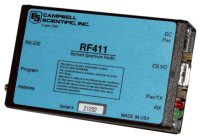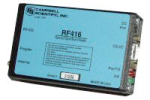
| 利用できるサービス | |
|---|---|
| 修理 | 非対応 |
| キャリブレーション | 非対応 |
| フリーサポート | 非対応 |
概要
The RF411 has a 920 to 928 MHz frequency range, which is used in Australia and Israel. This 100 mW spread-spectrum radio can transmit data to another RF411 radio, an RF431 radio, a CR211(X) datalogger, or an AVW211 interface.
The RF411 supports point-to-point and point-to-multipoint communications. It can serve as a field modem/radio while connected to the data logger or as a base station modem/radio while connected to a computer. The radio can also serve as a stand-alone RF router/repeater.
続きを読む利点と特徴
- Rugged, low-cost transceivers
- Can be used in the field as a transceiver or in the office as the base station
- Transmits up to one mile with omnidirectional antenna; up to 10 miles with higher gain directional antennas at ideal conditions
- Settings stored in non-volatile memory
- RS-232 port for connecting to a computer; CS I/O port for connecting to a data logger
- Frequency-hops over 25 channels avoids interference from other spread-spectrum radios
- Optional extended temperature testing
- Faster communication due to elimination of some small "link state packets"
- Ability to have stand-alone RF router/repeaters (up to 8 repeaters)
- Greater immunity to interference and RF collisions by using RF retries
- Reduced power consumption by the data logger, as the radios perform "packet address filtering"
- Built-in setup menus allow access to advanced functionality
- Designed for use in PakBus networks
イメージ

詳細
The RF411 reduces susceptibility to RF interference from other spread spectrum devices by providing user-selectable frequency hopping patterns. Spread spectrum radios spread the normally narrowband information signal over a relatively wide band of frequencies. This process allows communications to be more immune to noise and interference from RF sources such as pagers and cellular phones.
仕様
| Operating Frequency | 920 to 928 MHz |
| Type | Frequency Hopping Spread Spectrum (FHSS) Transceiver |
| RS-232 Data Rate | 38.4k, 19.2k, 9600, 4800, or 1200 bps |
| Channel Capacity | 65,000 Network Identifiers share 25 hop channels. |
| Frequency Hopping Patterns | Six different selectable patterns |
| Receiver Sensitivity | -110 dBm at 10-4 bit error rate (Campbell Scientific protocols will issue retries wherever a bit error occurs.) |
| Interference Rejection | 70 dB at pager and cellular phone frequencies |
| Transmitter Power Output | 100 mW (nominal) |
| Antenna Connector | Reverse polarity SMA |
| FCC ID | OUR9XTREAM |
| Power | 9 to 16 Vdc |
| LEDs | Power on, TX, RX, diagnostics |
| RS-232 Connector | 9-pin “D” female (4 wire: Tx, Rx, CTS, GND) |
| CS I/O Connector |
9-pin “D” male Newer dataloggers supply power to the RF411 radio on this connector. Dataloggers purchased before December 1997 require the pn 14291 Field Power Cable. |
| Power Connector | Barrel plug, center positive 12 V (used to connect the 14291 Field Power Cable) |
| Maximum Nodes in Network | 50 |
| Standard Operating Temperature Range | -25° to +50°C |
| Extended Operating Temperature Range |
-55° to +85°C The push button that allows you to check/edit programmable settings while the radio is connected to a computer may not operate at temperatures colder than -25°C. |
| Dimensions | 11.4 x 7.0 x 2.9 cm (4.9 x 2.8 x 1.2 in.) |
| Weight | 227 g (8 oz) |
Average Current Drain |
|
| Standby | < 1 mA (power-saving options used) |
| Receiving | 24 mA |
| Transmitting | < 75 mA |
互換性
注意: 以下は代表的な互換性情報を示しています。互換性のある製品や互換性のない製品をすべて網羅したリストではありません。
Data Loggers
| 製品 | 互換性 | 注意 |
|---|---|---|
| 21X (リタイア) | ||
| CR10 (リタイア) | ||
| CR1000 (リタイア) | ||
| CR1000X (リタイア) | ||
| CR10X (リタイア) | ||
| CR200X (リタイア) | ||
| CR206X (リタイア) | ||
| CR211X (リタイア) | ||
| CR216X (リタイア) | ||
| CR23X (リタイア) | ||
| CR295X (リタイア) | ||
| CR300 (リタイア) | ||
| CR3000 (リタイア) | ||
| CR500 (リタイア) | ||
| CR5000 (リタイア) | ||
| CR510 (リタイア) | ||
| CR6 | ||
| CR800 (リタイア) | ||
| CR850 (リタイア) | ||
| CR9000 (リタイア) | Although the CR9000 and CR9000X are compatible, RF411 radios do not support their fastest communication rates, and are therefore not practical for many CR9000(X) applications. | |
| CR9000X (リタイア) | Although the CR9000 and CR9000X are compatible, RF411 radios do not support their fastest communication rates, and are therefore not practical for many CR9000(X) applications. |
互換性に関する追加情報
Communications
Internal Radio of CR211(X) Dataloggers
The RF411 spread spectrum radio can communicate with the internal spread spectrum radio of our CR211(X) dataloggers. Certain RF411 settings must match the CR211(X) settings for communications between the radio and data logger to be successful. The factory default settings of these devices may not match; therefore, they may need to be reconfigured before communications can take place. For more information, refer to the Quick Reference Guide for Setting Up RF401-to-CR206 Communication application note (see Documents).
Other Spread-Spectrum Radios
The RF411 radios can be used in networks containing RF431 and RF410 radios. When RF411 radios are used in networks containing RF400 radios, the Protocol must be set to Transparent. Also, if RF410 and RF411 radios will be in the same RF proximity, do not use 28, 44, 52, 56, or 60 for the RF410 Net Address. RF410 radios with Net Addresses of 28, 44, 52, and 56 interfere with RF411 radios with Net Addresses of 0, 1, 2, and 3, respectively. The RF410 Net Address of 60 interferes with all RF411 Net Addresses.
Campbell Scientific does not recommend using the RF411 in networks containing FGR-115 or RF450 radios.
Transparent and PakBus Protocols
Do not mix RF411 radios set to the Transparent protocol with RF411 or RF431 radios set to either of the PakBus protocols, since this will produce RF traffic without any RF communications. However radios with the PakBus Aware and PakBus Node settings can coexist in the same network (i.e., some radios set to PakBus Aware and some radios set to PakBus Node).
Enclosure Considerations
A desiccated, non-condensing environment is required. The 14162 Mounting Kit includes hardware for securing the RF411 to an enclosure backplate (see Ordering Info).
ダウンロード
RF401 Series OS v.04 (646 KB) 14-08-2008
Current RF401, RF411, RF416 firmware. Requires the Device Configuration Utility.
よくある質問
RF411に関するよくある質問の数: 4
すべて展開すべて折りたたむ
-
The RF411 is a 100 mW, 920 to 928 MHz radio that requires true line of sight. In a dry environment, with absolutely no physical obstruction to impair the line-of-sight path, and with the proper and elevated antennas, the expected range is up to 10 miles.
-
はい。BMP5 Direct SDK は、次の 2 つの条件が満たされている限り、データロガーと通信できます。
- データロガーとコンピュータ間の通信リンクは透過的です。
- 過度の遅延はありません。
-
アンテナの選択は複数の基準によって決まります。
- 特定のステーションが通信する必要があるステーションの数を考慮してください。 1 つのリピーターまたはベース ステーションとのみ通信するリモート ステーションの場合、指向性アンテナまたは八木アンテナが適切な選択肢となる可能性があります。 対照的に、さまざまな場所からデータを受信するリピーター ステーションでは、全方向性アンテナが必要になる可能性があります。
- 2 点間の経路を越えるには高利得アンテナが必要かどうかを検討してください。高利得アンテナはより大きく、より高価になります。
アンテナの選択と設置場所の配置を支援するために、デモ キットをレンタルして使用し、経路の品質をテストすることを検討してください。Campbell Scientific は、RF401、RF430、CR206X、AVW206 用の 900 MHz デモ キットと、RF450 用のデモ キットを提供しています。サポートについては、Campbell Scientific にお問い合わせください。
記事とプレスリリース
Privacy Policy Update
We've updated our privacy policy. 詳細はこちら
Cookie Consent
Update your cookie preferences. クッキーの設定を更新する
